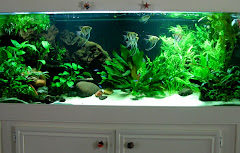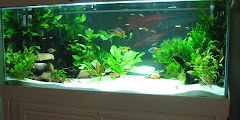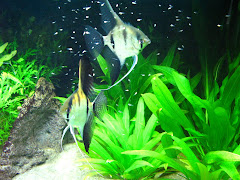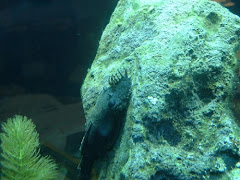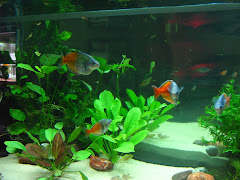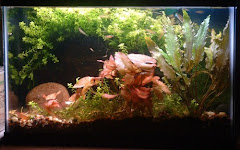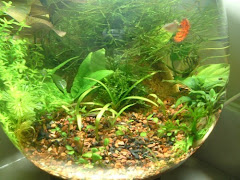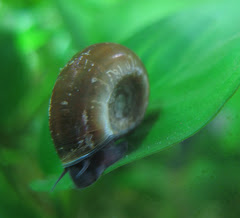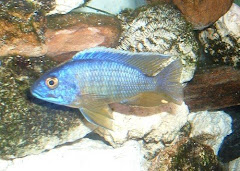I am not actively trying to breed my fish right now but I had to move this breeding pair out of my 150 as something of an emergency when I suddenly had a huge fight between this pair and another newly formed pair who were trying to move in on them. I have had angels kill each other in this situation and I had a nearly empty 29 sitting there, so I moved this well established pair into it right away - problem solved. They've been laying eggs forever but in a community tank never had a chance to hatch them out.
I've seen them picking at leaves and doing their thing, but I haven't seen any eggs. Friday afternoon I noticed some brisk activity in the tank and lo and behold, not eggs, but WIGGLERS! They snuck an entire batch of eggs past me (not hard to do) and hatched them out. It was the cutest thing. I haven't had angel babies in at least five years and I was excited, though not eager to deal with babies, with my busy work schedule and summertime family life.
This tank is in a horrible location, by the way, for any breeding pair, and was never meant to be a breeding tank at all, but a planted display, with blissfully ignorant and tolerant tetras or wee goldfish, or something like that. It is in a busy hallway at one end of my kitchen, on the bottom rack of a stand where Otis the F8 puffer resides above. Lots of nearby human and canine foot traffic and activity + close to the floor location = Crummy Breeding Tank.
I was having a party Friday night, and could not resist showing the kids and my other guests the wigglers. Well, gee, where are they? Oh, sorry, folks! Sometimes the parents get panicked and will actually eat their eggs or babies when they feel threatened, and everybody crouching in to take a look has stressed the tank too much. Oh well, nothin' to see here. I felt a little bad about it, but, as I said, I never meant to breed, and next time I'll just call one of my angel breeding friends at the first sign and they'll come by and snag them to raise.
Saturday afternoon I go to feed them and, what do I see? WIGGLERS! The parents had moved them to a more secure location for our party, then moved them BACK to the original leaf when the house calmed down. I should have realized this, because I saw my breeding pair move their brood years ago, but I had forgotten how they can be. It is just adorable.
Somebody needs to come by and get these babies! I know angels are not in short supply by any means, and getting your pair to STOP breeding is harder than getting them to START, but someone may want some wild/zebra DNA in their breeding program, since there are fewer wild strains available than domestic.
Here's Papa trying to run me off
And here's Papa thinking about moving the babies again, lol
Sunday, June 14, 2015
Saturday, April 11, 2015
Filtration
In reading some of the
threads on my fish forum lately (Central Virginia Aquarium Community) I have become very
interested in the topic of aquarium filtration. We all do it, in some way shape
or form, but there is a lot of diversity in how we all do it, even from one
tank to the other for the same fishkeeper.
I have kept super low-tech to NO tech tanks, utilizing plants to take care of a few fish and the fish waste taking care of the plants, low-tech setups with air pumps or water pumps driving small sponge filters, simple HOB medium-tech tanks and higher-tech canister filters with UV sterilization. I'd even consider canisters with UV and heat integrated into the return lines, as a way to streamline tank care and keep equipment hidden away.
I tend to keep aquariums as more of an artistic expression, as a living sculpture or painting that is part of my household decor, but at the same time having a keen interest in the fish themselves and how to make them happy at the same time as creating a visually appealing display. This is why, currently anyway, my goal is to filter the water but to hide the equipment necessary to do so.
However, that's not even the point here - no matter what your focus is in keeping your fish, there are still a ton of options, and several schools of thought on "ideal" filtration.
I have kept super low-tech to NO tech tanks, utilizing plants to take care of a few fish and the fish waste taking care of the plants, low-tech setups with air pumps or water pumps driving small sponge filters, simple HOB medium-tech tanks and higher-tech canister filters with UV sterilization. I'd even consider canisters with UV and heat integrated into the return lines, as a way to streamline tank care and keep equipment hidden away.
I tend to keep aquariums as more of an artistic expression, as a living sculpture or painting that is part of my household decor, but at the same time having a keen interest in the fish themselves and how to make them happy at the same time as creating a visually appealing display. This is why, currently anyway, my goal is to filter the water but to hide the equipment necessary to do so.
However, that's not even the point here - no matter what your focus is in keeping your fish, there are still a ton of options, and several schools of thought on "ideal" filtration.
I'm of TWO MINDS on the topic. I think
simple setups with sponge filters alone are marvelous, time tested and proven,
without question, and I have several classic Aquatop sponge filters stored away
for use anytime I need to set up something quick (I used to keep one running at
all times in the back corner of a tank solely to keep it seeded with bacteria
in case I had an issue and needed to pop a fish into a hospital/spawning/fry
growout tank). The other part of me LOVES technology and the new developments
in filtration that abound today catch my eye and intrigue me - I
not-so-secretly want to try out the newest aquarium toy or gadget on the
market.
How can it be that for so many people for so many years a simple sponge filter is the way to go, yet others swear by powerful water movers with compartments dedicated to chemical, mechanical and bio filtration? Why do some tanks need all that and others don't? Is all this tech completely unnecessary and just a way to appeal to the personality type that loves technology and is willing to spend $$$ to have it? I have no doubt that there are tanks out there requiring specialized filtration to mimic native conditions for fish or corals, for instance, but does the average FW tank need any tech at all?
How can it be that for so many people for so many years a simple sponge filter is the way to go, yet others swear by powerful water movers with compartments dedicated to chemical, mechanical and bio filtration? Why do some tanks need all that and others don't? Is all this tech completely unnecessary and just a way to appeal to the personality type that loves technology and is willing to spend $$$ to have it? I have no doubt that there are tanks out there requiring specialized filtration to mimic native conditions for fish or corals, for instance, but does the average FW tank need any tech at all?
I have perfectly happy tanks set up at both ends of the spectrum, and am not sure one way is better than the other, but it is certainly food for thought.
Wednesday, April 8, 2015
Fluval FX5 Purge Valve, and Did a Fish Pull a "Nemo" ?
 Subject: FX5 overhaul Subject: FX5 overhaul  Yesterday at 4:28 pm Yesterday at 4:28 pm |  |
I apologize for not getting pictures, because that would make a huge difference in reviewing my recent experience, but I'm old and am slow to the trend of whipping out my phone for every life event!
I have been running a Fluval (Hagen) FX5 on my 150 for six years. This filter has a handy purge valve at the bottom so you can attach a 5/8" tube to drain the filter and do a water change at the same time. I don't utilize this method, preferring to use a Python and vacuum debris from the tank while I change water. When I clean out the filter every month or so I disconnect the intake and outflow hoses, and drain the filter a bit so I can carry it to the sink or outside on the deck to rinse out the foam pads and rinse out the unit. The filter weighs about 70 pounds full of water, so draining it first is, for me, a must! NOTE: I know the recommended practice for rinsing out filter media and filters involves using dechlorinated water, and many are careful to stress the importance of this. I do not discourage or dispute the importance of attempting to preserve the bacterial colonies present in the filter media and filter itself, as they work with the mechanical filtration to maintain the cycle of the tank and prevent toxic levels of ammonia and nitrite. That said, I admit freely that I do not, in general, follow this practice at all. I take my FX5 (and my other large canister filters, Eheims and Rena/API Filstars) outside, weather permitting, and use the hose to rinse them out thoroughly, and use the strong spray from the hose to rinse the foam and ceramic media. I am on a municipal water system, so there is definitely chlorine present. In the cold weather months I do this in the sink, using the sink sprayer attachment to thoroughly clear the unit and the media of debris. I do the same with my HOB filters, running the boxes themselves under the tap and rinsing the media cartridges/foam pads under the tap as well, chlorine and all. My tanks are well established, and in my own personal experience over the past 30 years I have not had a problem cleaning my filters in this way. I don't tend to clean out filters on new tanks, or tanks that have not "settled in" and are still unstable, 6 months and earlier. After that, I consider the bacterial colonies present inside the tank to be adequate to handle the bioload even if I put a brand new filter on the tank, so killing off bacteria from the filter has never (*knocks wood*) caused a problem for me in all these years. When giving advice to those new to the hobby, however, I would recommend against doing things like I do them, and would always suggest rinsing filters and media in tank water or dechlorinated water, just to take that variable out of the equation, and to support best practices. This is a classic case of "do as I say, not as I do!" The last time I cleaned the FX5 of the finger tabs for the purge valve snapped cleanly off. I don't know why, since I don't use a tool or other forcible action to turn the valve to open it, but this rendered the valve almost useless, since you can't turn this very stiff valve without twisting using two fingers. Fortunately, you can buy a replacement valve for this filter. I paid $19.95, which is steep, and I'm sure if I went on ebay and shopped around a bit I could have found it for less, but I was impatient. The valve itself was perfectly functional and the filter was not leaking, but to clean the filter I'd be forced to open it up, remove the media baskets and scoop or siphon out the water manually before being able to lift the filter out from under the tank, and that's a pain. I received my replacement purge valve from Aquarium Parts Warehouse promptly, and after removing the media baskets and scooping out more than half the water (saved it in watering cans for my plants - they love the gunky filter water!) I took the unit out onto the deck to clean it and replace the valve. I am so happy when warm weather returns and I can perform this procedure with the garden hose on the deck, instead of my kitchen sink, which is not very large. I need the Utility Sink Fairy to pay me a visit. There's a little tab that keeps the purge valve from spinning in the housing, so you pry back this tab very slightly and the purge valve pulls straight out, and the new one pops right in - no problem. The O-rings are built in so that's all that is required, though I like to use a bit of Vaseline on the O-rings prior to installation. It's almost impossible to put the new valve in wrong, so I was grateful for the design. A little rant here: Anyone who has been in the hobby long enough knows that often the replacement part is a bit sturdier and more solid than the original part being replaced. Not always, but often. I was sure the finger tabs would be thicker and stronger on the replacement, but they are NOT. It is the same valve. I'll just have to be careful, though I don't know what caused the finger tab to break in the first place. I was disappointed, nonetheless. I decided to take this opportunity to remove the pump housing and clean out the impeller, which is not something I do very often. This is what it looks like, on the Hagen/Fluval site: 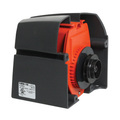 You simply use a Phillips head screwdriver, one that is 4-6" long and skinny, ideally, and remove the 4 small bolts that attach the motor to the filter body. The nuts are held in place on the backside of the fittings with retaining clips, so you don't have to keep track of these very tiny objects, just the tiny bolts. I removed it and looked down into the impeller, and found, to my surprise (and amusement, I have to say), 3 small ceramic filter media balls, Eheim Substrat. You've probably seen the stuff, it looks like this, and they're about 1/4" in diameter: 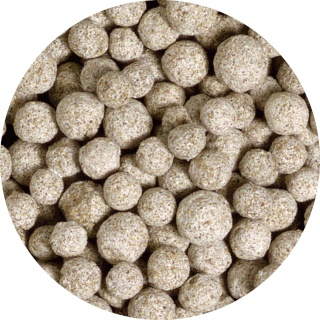 This is the part I wished I had taken a picture of, because the first thing I thought of was the movie Finding Nemo, where in an effort to escape the aquarium in the dentist's office Nemo goes inside the filter box and jams the filter with a piece of gravel from the tank bottom. It looked just like that. Fortunately, this did not render the filter useless, because it was certainly still quite functional and the flow was not terrible, though it had slowed and I thought it just needed cleaning. This is why I could afford to be amused at what I found. I use those media granules for biofiltration, but the basket in the FX5 has holes that are just BARELY smaller than the ceramic balls, and obviously a few got through, and made their way into the impeller. I'm lucky it didn't burn up the entire motor, actually, and I placed circular foam pads (Fluval, designed to fit the filter baskets) in the bottom of the tray that holds this biomedia, to mitigate any migration of media into other parts of the filter. Nylon media bags would be even better. I should have done that to start with, but didn't realize the balls could get through. Live and learn. Now my FX5 is completely rehabbed and ready for action once again. I carried it back in, connected the inflow and outflow hoses, allowing gravity to siphon-fill the filter, did my PWC and started it up. The flow was noticeably stronger, and I'm grateful to have found there was a problem before the filter was ruined. Sometimes I wish that this type of thing was my job, because I could do it all day - PWCs, aquascaping, rearranging, cleaning out filters, solving problems, researching, etc. When I finished with this tank I had not even noticed that it was now about 10 pm, since I started around 6:30. When you completely lose track of time, miss meals and other appointments without realizing it, you know you're doing something you were meant to do. So, don't be like me and put off filter maintenance! It pays to do routine checks of your valuable equipment that needs to be running reliably 24/7, 365. Thanks to this blog, recording my every waking thought about my tanks as well as every embarrassing mishap, I see that I've had this filter running for 6 years. I still love it, and highly recommend the Hagen Fluval FX5. | |
Thursday, February 19, 2015
Tetraodon biocellatus: The Figure-8 Puffer
The Fish
Tetraodon biolcellatus, commonly known as the figure-8 puffer, is frequently available in the aquarium hobby. It can be a rewarding pet, given their active and curious nature. They are colorful puffers, with pale bellies and green and yellow markings on their backs, typically reaching a size of about 3 inches. Their name comes from the two very dark marks on each side of their caudal (tail) fin, which can form a figure-8 pattern, but often looks like eye spots, or bi-ocellatus (two eyes). This is how you can easily tell whether you have a figure-8 versus some similarly marked puffers that can get much larger. They originate in Southeast Asia in freshwater locations that are slow-moving and shallow, where small crustaceans and snails are found. They enjoy an aquarium of at least 15 gallons, with the footprint longer rather than taller, because they spend time on the bottom and love to swim and explore. Calciferous rock and aragonite sand will help keep the pH raised in the tank to as high as 8 or greater for the health of the puffer, and the water temperature should be kept at 78-84F. Singletons seem to be the happiest and live the longest, but more than one could be kept if they are raised together from juveniles, and many keep them successfully with other small brackish species. You do not need to be an advanced aquarist to keep them, but you need to be comfortable with the basics and do your research prior to bringing one home.
The Water
You will find much disagreement on the subject of keeping the F8 puffer in brackish or freshwater in the home aquarium. A search on the topic will yield endless articles and forum threads on which is best, and, ultimately, they are frequently kept in both depending on preference. The fact is that they are found in freshwater locations in the Mekong (Cambodia), Malaysia and Borneo, and are shipped to distributors in freshwater, so your local shop will certainly receive them in such conditions. For simplicity’s sake, many shops will maintain them in freshwater and sell them as such, since it is often not cost-effective to set up and maintain a separate brackish tank for these fish. Information collected and reported by nature conservancies and environmental researchers such as FishBase make the distinction that this fish is “not a brackish species.”
However, research and anecdotal evidence compiled for many years on F8 puffers kept in aquaria seem to confirm that this species will enjoy a prolonged life, up to 15 years, if kept in lightly brackish water of around SG 1.005-1.008. Apparently, the immune system of the puffer is boosted and they are able to avoid succumbing to illness and parasites under these conditions, though hard scientific documentation of this circumstance is difficult to find. I personally consider the species to be best kept in brackish conditions, but this is a choice the fishkeeper needs to make on their own.
The Salt Mix
When keeping the puffer in a brackish setup, the salt used ought to be that intended for marine aquarium applications (table or human grade sea salt is not appropriate and lacks trace elements and calcium that is beneficial to the pH and the fish) and there are several ways to prepare the water to be used for future water changes. Some people mix large quantities of brackish water in dedicated trashcans or tubs, using water pumps to circulate the water and to pump it into the tank during water changes.
My method for a 20-long aquarium containing one puffer is to use a full marine mix prepared in 5-gallon plastic water jugs meant for water coolers. I typically purchase whatever marine mix I can find adequate for 10-gallons of water and split it between the two jugs, rotating/shaking the jugs until the salt mix is completely dissolved, and I’m left with full marine water. If you are using municipal water for your stored mix don’t forget to dechlorinate it as you prepare the solution. I stash these jugs in a closet until I’m ready for them. After vacuuming the tank and draining it by half, I begin to fill the tank with dechlorinated tap water like any other freshwater aquarium, but as I do so I pour in some of the dechlorinated marine mix water, which blends with the freshwater as it goes in, until I achieve the desired SG. I use a floating hydrometer and monitor this during the filling procedure, and keep the hydrometer in a corner of the tank at all times for instant reading.
Water changes are very important for these puffers, which do best with extremely clean water, and I generally change 50% of the water each week. Their meaty, messy diet means there is a lot of waste created by the fish and uneaten particles of food, so the bioload of one puffer is greater than that of a fish of similar size in the average freshwater tank. When doing water changes remember that any evaporation of tank water will concentrate the salts in the water, so you must utilize a hydrometer to monitor SG so it does not rise too much.
Please note that puffers are sensitive to toxins in the water, more so than other species, and must not be used to cycle a tank. The tank needs to be cycled prior to introducing the fish to the aquarium, using whatever cycling method you prefer.
The Selection of Your Puffer
At the store, the tank should be clean and not crowded. Look for a young puffer, and be sure to choose one that is active and seeking attention. Look at the belly and avoid the ones with a sunken belly; this is very common to see and is an indication the fish is not eating for one reason or another. If the belly is very slightly concave that is not of concern, since they have a fairly rapid digestive system, in my experience, and not too long after a hearty meal the belly has gone flat again. However, extremely sunken bellies are a common sight, either due to the shopkeeper not realizing what the puffer needs to eat (they will not take flake or pellet/prepared fish food) or due to illness.
Also make sure the puffer’s body is free of signs of ich or bacterial infections, and the fins are not split or cloudy. Some minor fin injuries are not unusual, however, especially when housed with other puffers, so the fish doesn’t have to be perfect, but be sure it is not ill or carrying a disease. The fins and the color of the puffer will improve in the home aquarium with target feeding and clean water, as well as appropriate tankmates or the comfort of a tank to himself.
The Acclimation
Care should be taken when introducing your new puffer to the home aquarium. As mentioned, the tank should be cycled prior to the new fish’s arrival, but keep in mind that the beneficial bacteria that complete the “cycle” of a freshwater aquarium are slightly different from those that cycle a saltwater setup; a sudden switch to brackish could disturb the cycle and harm the fish with toxic levels of ammonia and nitrite. If you determine that the puffer was kept in the shop in freshwater conditions, be sure to start him out in a freshwater tank at home. Gradually increase the specific gravity by 0.001 or 0.002 per week until you reach your goal, and the bacteria will proliferate along with the increase in salinity, keeping your tank healthy and cycled. The fish will also become acclimated to the brackish tank in a gradual fashion, which will result in a smooth transition to his new home.
The Tank
These puffers tend to be found in the benthic zone in nature, or the lowest level of the water near the substrate of the aquarium, due to their constant search for crustaceans and snails. They wander around, in continuous motion, searching the sand or gravel for prey. The puffer will appreciate adequate open space, but it is also important to provide rocks, small caves, archways and paths to other areas of the tank, separated by decor, to keep the puffer interested and prevent boredom. For this reason, as well as to provide the additional benefit of buffering the water, I prefer to use buffering sand (“cichlid” sand or aragonite/coral sand) as well as base rock (available for marine setups, used to propagate organisms for “live rock”) or other calciferous rock decor. I stack the rocks down the very center of the tank lengthwise, with caves and empty spaces in between so the puffer is able to travel to the other side of the tank and can enjoy a complex set of paths and trails to explore, with breaks in sight lines. A bored puffer will “pace” back and forth the length of the tank, and will be more likely to attack and disturb tankmates. Some aquarists use plastic tubes and other aquarium-safe objects to occupy the puffer’s time and drain their ample energy.
Filtration of the tank needs to be strong or even overdone in order to create a high turnover of water and maintain pristine water conditions, though a strong current is not appreciated by these fish. Again, Figure-8 puffers have no scales and are intolerant of ammonia or nitrite, so it is important to adhere to a strict maintenance schedule. It is possible to grow plants in brackish tanks, and Java fern (Microsorum pteropus) or Java moss (Taxiphyllum barbieri) is often chosen. Figure-8 puffers will not disturb plants unless they find an unsuspecting snail there.
The Diet
Puffers have teeth that are beak-like, formed by two plates. These teeth grow continually, so without the proper hard diet the teeth will need to be trimmed manually. This procedure can be done, and there is information available on the internet to help educate the puffer owner about it, but I prefer to provide plenty of mollusks, snails and crustaceans in their diet to mitigate the risks associated with teeth trimming. You can buy frozen seafood at the grocery store, like small clams, mussels, shrimp and crab legs, and thaw them out in cool water, breaking them up with a hammer or shears so the puffer has to scrape the meat from the shell, or crunch through the shell, which will keep the teeth pared down.
Another suitable food source is my puffer’s favorite: snails. Since the aquarium hobby is full of snails of varying species, they are usually easy to come by. Ramshorn snails are simple to propagate in a separate tank and fed to the puffer regularly. Pond snails and any other type of aquatic snail are also easily found, as many consider them a nuisance. Some of your fellow fishkeepers may have an unwanted proliferation of snails and will be happy for you to come over and collect them for your puffer. Snails can also be purchased from eBay, Aqua-Bid or other online sources for relatively low cost, added to a small tank of their own, fed veggies and allowed to reproduce for future use. The puffer diet should be varied, though, so alternating the type of meaty foods will ensure a healthy and happy fish. It can be quite fascinating to watch the puffer anticipate and tear into his meal, attacking the shell relentlessly with much vigor and enthusiasm. My own puffer will slap the surface of the water with his tail, sometimes splashing a bit onto the adjacent wall, to indicate that it is feeding time!
When the puffer eats they make a bit of a mess, and do not tend to go around and pick up tiny bits of food, so this is where attention to housekeeping comes in focus. During water changes you’ll be vacuuming up leftovers and bits of shell so they don’t accumulate and foul the water. For a sandy substrate I take my hand and gently wave it to disturb the surface and raise bits of leftovers so I can vacuum them up without siphoning out the sand. You can also use a spatula or other device to stir the water gently to lift debris for removal.
The Puff
Finally, let’s address the issue of puffing. This is, of course, a fish that is known to inflate its body with water or air as a defense mechanism, making it larger and more intimidating, or to make it appear unappetizing and difficult for the predator to swallow. The questions that are always asked of me is, “does it puff up?” or, “can you make it puff up?” The answer to both questions is a firm NO. I never want my puffer to puff up, as it is quite stressful on the animal and there can be complications associated with puffing up, like trapping air inside itself (if it is near the surface) or being unable to deflate properly. This unique behavior is truly a life or death response, and I never want my puffer to feel that it has to resort to inflation. In the approximate six years since I've had him I have moved his tank twice, and he has never inflated, even when being netted and moved. Care is taken to avoid chasing the fish around and causing stress, and to net him as slowly and gently as possible, best done while distracted with a morsel of food. Don’t puff the puffer! He’ll be better for it.
Resources
I am not a scientist, nor an expert on the subject of figure-8 puffer fish. The information provided here is the result of my own experience and my own research, and is based on the experience and research of other, more experienced puffer keepers. Below you will find some excellent sources of additional reading on this most interesting and rewarding aquarium species.
Subscribe to:
Posts (Atom)



